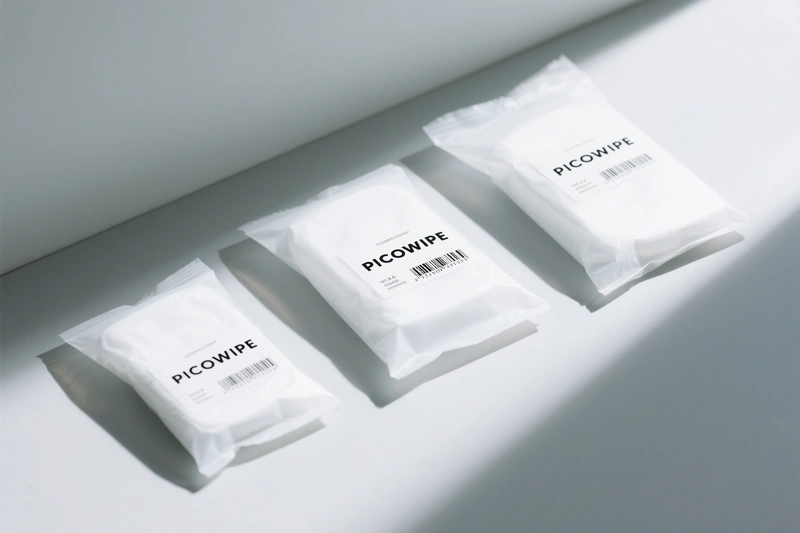By [email protected] — Charting the depths of expertise
This article introduces the relationship between nonwoven fabrics and nonwoven cleanroom wipes, along with their manufacturing processes. Essentially, a nonwoven cleanroom wipe is a type of nonwoven fabric. It includes two mainstream types: ① Air-laid nonwoven wipes (100% cellulose, strong water and oil absorption); ② Spunlaced nonwoven wipes with plant and chemical fibers (e.g., 55% cellulose + 45% polyester, good wet and dry strength, used for high-end wiping, wet wipes, etc.).
1. What is Nonwoven Fabric?
Nonwoven fabric is a sheet-like material made directly from fibers that are bonded or entangled through chemical, mechanical, or thermal methods, without the need for spinning or weaving.
Key Features: Breathable, lightweight, cost-effective, and functionally versatile (can be made waterproof, absorbent, filtering, antibacterial, etc., through different processes). Core Manufacturing Steps: ① Web Formation: Laying fibers into a web. ② Web Consolidation: Strengthening the web through methods like needle-punching, hydroentangling (spunlacing), thermal bonding, or chemical bonding.
Summary of Nonwoven Fabric Types, Features, and Applications
| Type | Process/Definition | Key Features | Common Applications |
|---|---|---|---|
| Spunlaced Nonwoven | High-pressure micro-water jets are sprayed onto a fiber web, causing the fibers to entangle and consolidate into a fabric. Also known as hydroentangling. | The primary process for cleanroom nonwoven wipes. Highly absorbent, breathable, and strong. | Medical gauze, facial mask sheets, wet wipes, makeup remover pads, cleanroom nonwoven wipes. |
| Thermal Bonded Nonwoven | A web is infused with hot-melt adhesive materials (fibers or powder), which are then heated, melted, and cooled to consolidate the fabric. | Smooth surface, relatively stiff and firm, good shape retention. | Top sheets for diapers and sanitary napkins, apparel interlinings, shopping bags, folders. |
| Air-laid Nonwoven | Wood pulp fiberboard is de-fibered into single fibers, which are then agglomerated onto a forming screen by air currents and consolidated. | Also known as dust-free paper or dry-laid paper nonwovens; has excellent absorbency. | Sanitary products (e.g., sanitary napkins), filter media, industrial wipers, traditional nonwoven cleanroom wipes. |
| Wet-laid Nonwoven | Fiber raw materials are opened in a water medium to form a suspension slurry, which is then formed into a web in a wet state and consolidated. | Good uniformity, high strength, soft hand-feel. | Wallpaper, tea bags, leather substrates, specialty papers. |
| Spunbond Nonwoven | A polymer is extruded and stretched to form continuous filaments, which are laid into a web. The web is then self-bonded, thermally bonded, chemically bonded, or mechanically reinforced. | Excellent strength, durable, breathable, high production efficiency, low cost. | Medical/hygiene (surgical gowns, outer layer of masks, protective suits), packaging, furniture covering, geotextiles. |
| Meltblown Nonwoven | A molten polymer is extruded through a die into high-velocity hot air, forming microfibers that are collected and consolidated into a fabric. | Extremely fine fibers, very high filtration and barrier efficiency, good oil absorption. Its main weakness is low strength and brittleness, leading to easy wear and shedding. | The core filter layer of face masks, air and liquid filtration media, oil-absorbing materials, thermal insulation. |
| Needle-punched Nonwoven | A fluffy web is consolidated by the repeated action of barbed needles piercing through it. | Bulky structure, good abrasion resistance, high strength, good filtration properties. | Geotextiles, automotive interiors (carpets, headliners), filter felts, artificial leather substrates, insulation materials. |
| Stitch-bonded Nonwoven | A web or yarn layer is reinforced using a warp-knitting structure. | Can be combined with other materials to enhance product performance and added value. | Apparel interlinings, curtains, decorative fabrics, shoe materials, artificial leather substrates. |
| Chemical Bonded Nonwoven | A bonding agent (like latex or resin) is applied to a fiber web via dipping, spraying, or printing, followed by drying and curing. | Low cost, high production speed, adjustable stiffness. | Disposable goods (tablecloths, medical bed sheets), stiff apparel interlinings (collars, cuffs), filter media substrates, decorative fabrics. |
| Composite Nonwoven | Made by combining two or more layers of nonwovens from different processes. The most typical is SMS (Spunbond-Meltblown-Spunbond). | Combines the advantages of each layer. For example, SMS has the strength of spunbond and the barrier properties of meltblown, compensating for the latter's weakness. | Face masks use an SMS structure. Medical protective gear (high-end surgical gowns, protective suits), advanced hygiene products, high-efficiency filter media. |
2. Nonwoven Processes for "Nonwoven Cleanroom Wipes"
The product commonly known as a nonwoven cleanroom wipe in cleanrooms primarily uses cellulose and polyester as raw materials. Its manufacturing process is mainly pure spunlacing, or a composite method of air-laying + spunlacing.
| Process | Description | Product Positioning |
|---|---|---|
| Air-laid | The traditional method for making nonwoven wipes, also called dry-laid papermaking. It is primarily made of 100% cellulose. Because the fibers are short and weakly bonded, its shedding rate is average. | Extremely high water and oil absorbency, but poor wet strength. Industrial wipers. |
| Spunlace (Most Common) | The most mainstream manufacturing method for cleanroom nonwoven wipes. Cellulose is laid directly onto a polyester fiber web (commonly 55% cellulose + 45% polyester) and then entangled with spunlacing. Low shedding rate, but much higher than a woven/knitted cleanroom wipe. | High wet strength, durable, and tear-resistant. General and high-end industrial wipers, cleanroom nonwoven wipes, medical dressings, wet wipes. |
| Air-laid + Spunlace | An air-laid process first creates the absorbent cellulose layer, which is then combined with a reinforcing layer (like polyester fibers) using spunlacing. Lower shedding rate, but still much higher than a woven/knitted cleanroom wipe. | For applications with higher requirements for uniformity, absorption speed, and structure. |


